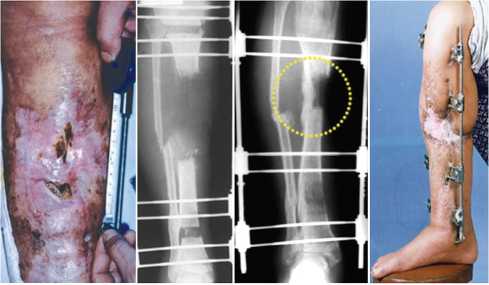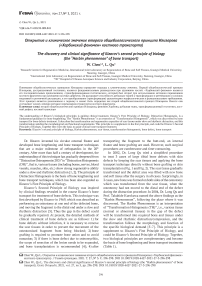The discovery and clinical significance of Ilizarov's second principle of biology (the “Harbin phenomenon” of bone transport)
Автор: Chen Weiwei, Qu Long
Журнал: Гений ортопедии @geniy-ortopedii
Рубрика: Оригинальные статьи
Статья в выпуске: 3 т.27, 2021 года.
Бесплатный доступ
The understanding of Ilizarov’s biological principles is guiding clinical treatment. Ilizarov’s First Principle of Biology, Distraction Histogenesis, is a fundamental guidance for bone lengthening. The “Harbin Phenomenon” is an extension of “Transformation Histogenesis”, which was discovered by bone transport for bone defects treatment. It describes the transformation and regeneration capacities of scar tissues under slow and rhythmic distraction, and this transformation satisfies the morphological and functional requirements. This principle is a supplement to the first principle, and could be Ilizarov’s Second Principle of Biology. Together they form the basis to guide clinical bone transport treatment.
Ilizarov's second principle of biology, harbin phenomenon, scar tissue, transformation histogenesis, bone defect, bone transport
Короткий адрес: https://sciup.org/142229723
IDR: 142229723 | УДК: 616.71-003.93-089.843 | DOI: 10.18019/1028-4427-2021-27-3-296-298
Текст научной статьи The discovery and clinical significance of Ilizarov's second principle of biology (the “Harbin phenomenon” of bone transport)
Dr. Ilizarov invented his circular external fixator and developed bone lengthening and bone transport techniques that are a major milestone of orthopaedics in the 20th century. After more than half a century of development, the understanding of this technique has gradually deepened from “Distraction Osteogenesis (DO)” to “Distraction Histogenesis (DH)”, that is, various tissues (including bones, nerves, blood vessels, muscles, skin, etc.) show strong regenerative ability under a slow and rhythmic distraction [1, 2]. The principle of Distraction Histogenesis is the basis of bone lengthening and bone transport techniques, which has been also regarded as Ilizarov’s First Principle of Biology.
Ilizarov’s Second Principle of Biology was inspired by clinical findings revealed in the course Ilizarov’s bone transport for treatment of bone defects. This technique was first developed by Ilizarov in 1969, which was described as performing an osteotomy at one end of the defected bone, and moving the fragment to the distal end under a slow and rhythmic distraction [3]. Thus the gap in the defect could be gradually repaired. At present, the detailed methods of clinical treatment of bone defects are as follows: 1) for bone defects without infection, it is necessary to remove the scar tissues in order to prevent the movement of the osteotomized fragment from being blocked; 2) bone grafting is required to promote bone union and to avoid nonunion; 3) if there is bone defect due to osteomyelitis, the scope of resection of the lesion needs to be expanded, and bone transplantation is recommended [4]; 4) after transporting the fragment to the butt-end, an internal fixator and bone grafting are used. However, such surgical procedures are cumbersome and time-consuming.
In 2002, Dr. Long Qu tried a simplified procedure to treat 3 cases of large tibial bone defects with skin defects by keeping the scar tissues and applying the bone transport technique directly without bone grafting or skin transplantation (Fig. 1 and Fig. 2). The scar tissue gradually transformed and the defect area was filled with new bone and soft tissue after the surgery in all cases. Surprisingly, in 2 cases, new bone was formed on both sides of the osteotomy which was transformed from the scar tissue, when the osteotomy had not moved to the distal end of the defect during the distraction procedure. In 2004, Dr. Long Qu and Prof. Takahide Kurokawa named the above findings as the “Harbin Phenomenon”, following the place where it was discovered. The Harbin Phenomenon is an interpretation of “Transformation Histogenesis (TH)”, i.e., various tissue (normal or abnormal tissues) in the gap of the defect will be transformed into required bone and tissues under the slow and rhythmic distraction/compression, and the transformation follows the morphology and function of the specific biological demand [5–7]. This principle is a supplement to Ilizarov’s First Principle of Biology, and could be Ilizarov’s Second Principle of Biology. Together, two biological principles are complementary and become the basis of bone lengthening and bone transport treatments (Table 1).

Fig. 1. This figure shows the effects of bone transport in an 18-year-old woman with 20-cm tibial defect and osteomyelitis, who has undergone 5 operations of internal fixation and skin grafting before bone transport treatment: a – the intraoperative appearance shows large soft tissues and skin defects with scar tissues; b, c – X-ray images during bone transport process show the osteotomy was performed on the distal side of the defect, and transport towards the proximal side; d – X-ray image at the end of bone transport shows new bone was formed on both the upper side (9 cm) and the lower side (11 cm) of the osteotomy (a yellow dashed circle represents Ilizarov’s Second Principle of Biology and the red solid circle represents Ilizarov’s First Principle of Biology); e – when bone transport procedure stopped, scar tissues had been transformed into new skin tissues; f – postoperative X-ray image shows 20 cm of new bone regenerated in the defect area; g – postoperative appearance shows that the bone and skin defects were repaired and healed

Fig. 2. This figure shows the effects of bone transport in a 46-year-old male with 10-cm bone defect, osteomyelitis and skin defect in the right tibia: a – preoperative appearance shows soft tissue defect and skin defect; b – intraoperative X-ray image shows a 10-cm tibia defect, and osteotomies performed on both upper and lower tibia; c – postoperative X-ray image shows the scar tissues within the defect transformed into 3 cm of new bone (yellow dotted circle represents Ilizarov’s Second Principle of Biology); d – postoperative appearance shows that the bone and skin defects were repaired and healed
a b c d
Table 1
The Biological Principles of Ilizarov Technique
|
Principle |
Ilizarov’s First Principle of Biology |
Ilizarov’s Second Principle of Biology |
|
Discovery |
Discovered in from bone lengthening treatment |
Discovered in from bone transport treatment (the “Harbin Phenomenon”) |
|
Core idea |
Distraction Histogenesis (DH) |
Transformation Histogenesis (TH) |
|
Discoverer |
Gavriil Abramovich Ilizarov |
Kurokawa Takahide & Qu Long |
|
Description |
Various tissues, including skin, muscle, nerve and blood vessels, will regenerate and repair in a predictable way under slow and rhythmic distraction |
Various tissues (normal or abnormal tissues) in the gap of the defects will transform into normal tissues and bones under the condition of chronic distraction and compression, according to the morphological and functional requirements |
Ilizarov’s Second Principle of Biology has further extended the understanding of the transformation and regeneration capacities of abnormal tissues and the understanding of “scar tissues”. As one of the forms of abnormal tissues in the body, the scar tissues can also be changed and transformed under continuous tension and pressure. This principle provides theoretical guidance for the implementation of bone transport technique. The traditional knowledge, such as the scar tissue embedded in the bone defect should be removed in advance, removal of butt-end bone and bone grafting should be performed when the bone end is difficult to unite, should be changed based on this principle. For bone defects accompanied by soft tissue defects or skin defects, bone transport can be adopted without removal of scar tissues, hardened bone ends, and without bone or skin grafting, thus fully relying on the capacity of tissue transformation and regeneration.
In the process of using the Ilizarov's technique, we always have new discoveries and new understanding in our exploration. Ilizarov’s First Principle of Biology is the interpretation of the “Regeneration” of normal tissues produced by force, and Ilizarov’s Second Principle of Biology is the interpretation of the “Transformation” of abnormal tissues produced by force. The two complement each other and together play an important guiding role in Ilizarov's bone lengthening and bone transport techniques. The new understanding of scar tissues can also provide theoretical guidance and inspire the development of new clinical treatment methods for complex and refractory diseases.
Список литературы The discovery and clinical significance of Ilizarov's second principle of biology (the “Harbin phenomenon” of bone transport)
- Илизаров Г.А., Матвеенко В.Н., Ирьянов Ю.М. Формирование органического матрикса дистракционного регенерата кости и особенности его минерализации при удлинении голени в эксперименте // Вопросы Мед. Химии. 1982. Т. 28, № 6. С. 27-33.
- Ilizarov G.A. Transosseous osteosynthesis: Theoretical and Clinical Aspects of the regeneration and growth of tissue. 1st Ed. Berlin: Springer-Verlag. 1992. 800 p. DOI: 10.1007/978-3-642-84388-4
- Илизаров Г.А., Ледяев В.И. Замещение дефектов длинных трубчатых костей за счёт одного из отломков // Вестник Хирургии им. И.И. Грекова. 1969. Т. 102, № 6. С. 77-84.
- Paley D. Problems, Obstacles and Complications of Limb Lengthening by the Ilizarov Technique // Clinical Orthopaedics and Related Research, January 1990. Т. 250. С. 81-104.
- New clinical applications of bone lengthening and bone transport techniques / L. Qu, T. Kurokawa et al. // J. Jap. Assoc. External Fixation and Limb Lengthening (JAEFLL). 2004. Vol. 15. P. 93.
- Qu L. Bone transfer technique in the treatment of bone defect and nonunion. Clinical application of Ilizarov's technique. Beijing: The Peoples Medical Publishing House. 2009.
- Qin S., Li G., Progress in the application of Ilizarov's technique in orthopedics. Beijing: People's Military Medical Press. 2014.


